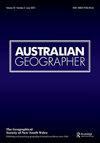利用流动性理论研究气候变化与人类运动之间的关系
IF 2
2区 社会学
Q2 GEOGRAPHY
引用次数: 0
摘要
本文章由计算机程序翻译,如有差异,请以英文原文为准。
Using mobilities theory to study the nexus between climate change and human movement
ABSTRACT Scholarship on ‘climate migration’ has traditionally focussed on the forced movement of people caused by the environmental impacts of climate change. However, this is only one part of the nexus between human movement and climate change. Consequently, researchers drawing on the ‘mobilities paradigm’, particularly those examining the topic of ‘mobility justice’, have sought to develop more encompassing conceptualisations of ‘climate mobilities’. In synthesising the different trajectories of this work, this paper identifies four key themes emerging within early ‘climate (im)mobilities’ scholarship. First, research on the way climate-related movement and stasis are represented and imagined. Second, examination of climate change’s impact on existing and ontologically significant (im)mobility practices. Third, analysis of the power relations that are enacted through climate (im)mobilities. And fourth, study of the inter-scalar nature of climate change-based (im)mobilities connecting disparate local mobility practices through their relationship to climate change. Research findings based on these themes are providing holistic accounts of the relationship between climate change and movement, and thus laying the groundwork for informed justice-based interventions in climate (im)mobility systems.
求助全文
通过发布文献求助,成功后即可免费获取论文全文。
去求助
来源期刊

Australian Geographer
GEOGRAPHY-
CiteScore
4.10
自引率
8.30%
发文量
33
期刊介绍:
Australian Geographer was founded in 1928 and is the nation"s oldest geographical journal. It is a high standard, refereed general geography journal covering all aspects of the discipline, both human and physical. While papers concerning any aspect of geography are considered for publication, the journal focuses primarily on two areas of research: •Australia and its world region, including developments, issues and policies in Australia, the western Pacific, the Indian Ocean, Asia and Antarctica. •Environmental studies, particularly the biophysical environment and human interaction with it.
 求助内容:
求助内容: 应助结果提醒方式:
应助结果提醒方式:


